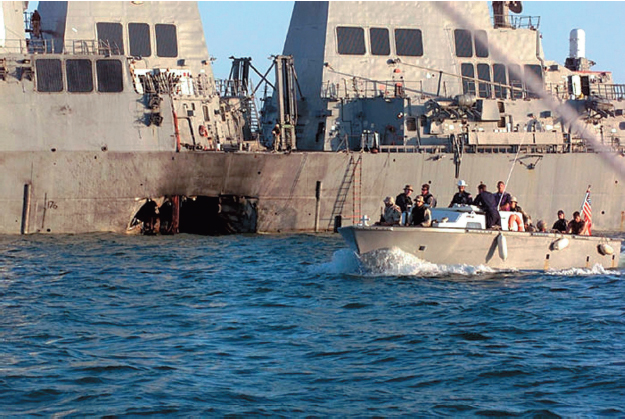America’s History: Printed Page 1022
America: A Concise History: Printed Page 929
America’s History: Value Edition: Printed Page 905
Post-Cold War Foreign Policy
Politically weakened domestically after 1994, Clinton believed he could nonetheless make a difference on the international stage. There, post-Cold War developments gave him historic opportunities. The 1990s was a decade of stunning change in Europe and Central Asia. A great arc of newly independent states emerged as the Soviet empire collapsed. The majority of the 142 million people living in the former Soviet states were poor, but the region had a sizable middle class and was rich in natural resources, especially oil and natural gas.
Among the challenges for the United States was the question of whether to support the admission of some of the new states into the North Atlantic Treaty Organization (NATO). Many observers believed, with some justification, that extending the NATO alliance into Eastern Europe, right up to Russia’s western border, would damage U.S-Russian relations. However, Czechoslovakia, Poland, and Hungary were also eager to become NATO members — an outcome that would draw into the Western alliance three nations that Stalin had decisively placed in the Soviet sphere of influence at the close of World War II. Clinton encouraged NATO admission for those three countries but stopped short of advocating a broader expansion of the alliance during his terms in office. Nonetheless, by 2010, twelve new nations — most of them in Eastern Europe — had been admitted to the NATO alliance. Nothing symbolized the end of the Cold War more than the fact that ten of those nations were former members of the Warsaw Pact.
The Breakup of Yugoslavia Two of the new NATO states, Slovenia and Croatia, emerged from an intractable set of conflicts that led to the dissolution of the communist nation of Yugoslavia. In 1992, the heavily Muslim province of Bosnia-Herzegovina declared its independence, but its substantial Serbian population refused to live in a Muslim-run multiethnic state. Slobodan Milosevic, an uncompromising Serbian nationalist, launched a ruthless campaign of “ethnic cleansing” to create a Serbian state. In November 1995, Clinton organized a NATO-led bombing campaign and peacekeeping effort, backed by 20,000 American troops, that ended the Serbs’ vicious expansionist drive. Four years later, a new crisis emerged in Kosovo, another province of the Serbian-dominated Federal Republic of Yugoslavia. Again led by the United States, NATO intervened with air strikes and military forces to preserve Kosovo’s autonomy. By 2008, seven independent nations had emerged from the wreckage of Yugoslavia.
America and the Middle East No post-Cold War development proved more challenging than the emergence of radical Islamic movements in the Middle East. Muslim nations there had a long list of grievances against the West. Colonialism — both British and French — in the early decades of the twentieth century had been ruthless. A U.S.-sponsored overthrow of Iran’s government in 1953 — and twenty-five years of American support for the Iranian shah — was also a sore point. America’s support for Israel in the 1967 Six-Day War and the 1973 Yom Kippur War and its near-unconditional backing of Israel in the 1980s were particularly galling to Muslims. The region’s religious and secular moderates complained about these injustices, but many of them had political and economic ties to the West, which constrained their criticism.

This situation left an opening for radical Islamic fundamentalists to build a movement based on fanatical opposition to Western imperialism and consumer culture. These groups interpreted the American presence in Saudi Arabia as signaling new U.S. colonial ambitions in the region. Clinton had inherited from President George H. W. Bush a defeated Iraq and a sizable military force — about 4,000 Air Force personnel — in Saudi Arabia. American fighter jets left Saudi Arabian air bases to fly regular missions over Iraq, enforcing a no-fly zone, where Iraqi planes were forbidden, and bombing select targets. Clinton also enforced a UN-sanctioned embargo on all trade with Iraq, a policy designed to constrain Saddam Hussein’s military that ultimately denied crucial goods to the civilian population. Angered by the continued U.S. presence in Saudi Arabia, Muslim fundamentalists soon began targeting Americans. In 1993, radical Muslim immigrants set off a bomb in a parking garage beneath the World Trade Center in New York City, killing six people and injuring more than a thousand. Terrorists used truck bombs to blow up U.S. embassies in Kenya and Tanzania in 1998, and they bombed the USS Cole in the Yemeni port of Aden in 2000.
The Clinton administration knew these attacks were the work of Al Qaeda, a network of radical Islamic terrorists organized by the wealthy Saudi exile Osama bin Laden. In February 1998, bin Laden had issued a call for holy war — a “Jihad against Jews and Crusaders,” in which it was said to be the duty of every Muslim to kill Americans and their allies. After the embassy attacks, Clinton ordered air strikes on Al Qaeda bases in Afghanistan, where an estimated 15,000 radical operatives had been trained since 1990. The strikes failed to disrupt this growing terrorist network, and when Clinton left office, the Central Intelligence Agency (CIA), the State Department, and the Pentagon were well aware of the potential threat posed by bin Laden’s followers. That was where things stood on September 10, 2001.
PLACE EVENTS IN CONTEXT
Question
In what specific ways were foreign policy developments during the Clinton presidency evidence of the end of the Cold War?